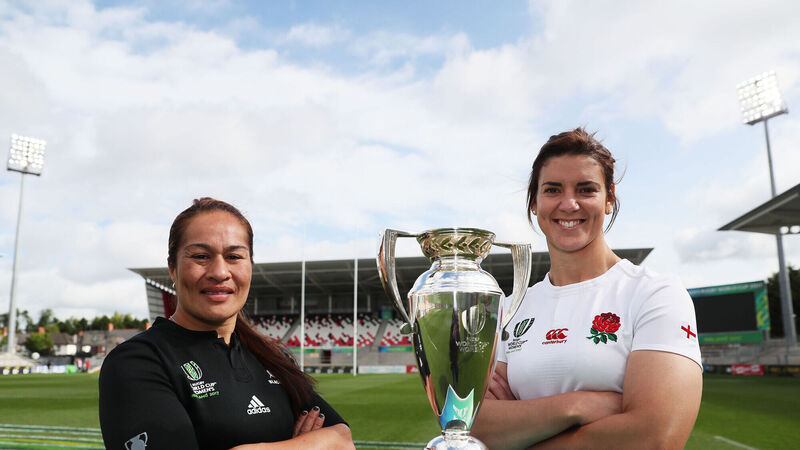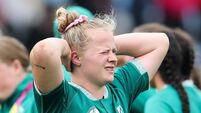Paul Rouse: Women were expected to watch, admire and help with the catering

England captain Sarah Hunter (right) and New Zealand captain Fiao’o Faamausili with the Women’s Rugby World Cup, held in Ireland in 2017.
Thirty years ago this week, the Women’s Rugby World Cup was played for the first time. The competition was played out in South Wales, with Cardiff as its hub.
Twelve countries – USA, England, New Zealand, Netherlands, Canada, Spain, Wales, Sweden, Italy, Japan, the USSR and France – took part. The competition was held despite the failure of the International Rugby Board to recognise it and despite the inability to secure a sponsor. Most of the women had to pay their own way there.
The lore of the event is that the Soviet Union team arrived with just enough food for two days and with no cash. It is claimed they had hoped to sell vodka, champagne and caviar to fund their stay – but this plan did not survive an encounter with customs. In the end, local people and businesses in Wales stepped in to fund the team – and the team also sold commemorative memorabilia around the games they played in.
In the final, the USA defeated England in the final in front of 3,000 supporters.
In an interview before that game, Tara Flanagan – one of the stars of the team – explained why she had switched from basketball to rugby. She said it was because it was a hard game and because, unlike basketball, you couldn’t foul out: “We’re going to beat the hell out of somebody.”
The competition was driven by a group of women from London – where the game was making inroads, particularly around Richmond, one of whom, Alice Cooper, said as the competition was underway: “So many people come with misconceptions of what they think they are going to see. But I think anybody who comes along will have found within 10 minutes they forgot they were watching women playing rugby.”
So why were Ireland not present? The simple fact is that women who wished to play rugby in Ireland suffered such rank discrimination and opposition that it was only in 1993 that the first international rugby match involving Irish women was played. That first international was played against Scotland in Edinburgh on St Valentine’s Day, 1993 – it ended in a 10-0 loss for Ireland but the very fact of its playing renders the result immaterial.
By contrast, the first international national rugby match involving Irish men had been played in 1875. Beneath that sentence flow rivers of chauvinism, ignorance, neglect and denial. Sport reveals the nature of a society in so many different ways. In this instance, it demonstrates how women fitted into that society.
In all of this, the place of Irish women in the world of sport was emphatically all of a piece with that of women across the British Empire. Most of the national and international organisation, which now governs sport, was founded in the years between 1850 and 1900. These institutions reflected the gender prejudices of the times in which they were formed. This was – emphatically – a man’s world and sport inevitably reflected this simple fact.
But the newly formed sporting organisations such as the Football Association (1863) and the Rugby Football Union (1871) were not just set up for men, but for a very definite type of man.
The sporting male was to be strong, vigorous and tough. To be good at sport was to be naturally male. At least that it is how the rhetoric of the time presented it. This was a rhetoric that was pulled from the elite public schools of England (all, essentially, the preserve of boys of a certain class) and ultimately applied to the developing world of sport.
There was a place for women in this world – but that place was not on the playing field. Women were expected to watch and admire, present the garlands afterwards, swoon, and help with the catering.
There was a certain pride expressed in this discrimination. The Yorkshire Rugby Union was told by one of its officers in 1889: ‘We have no dealings with women here.’ And this point was repeatedly reinforced. For example, later in 1932 a one-time President of the Rugby Football Union said: ‘Ours is a game not founded for women.’
Such women as did play rugby had to do so in secret, although in 1917 there was a fundraising charity match in Cardiff featuring Cardiff Ladies against Newport Ladies.
In the 1960s and 1970s – often driven by the development of the game in universities – women playing rugby organised into clubs and then into national governing bodies in countries such as France, Canada, the USA, the Netherlands and Spain.
In Ireland, it was only really in the early 1980s that the first cracks of light appeared. During that decade rugby matches were played on an ad-hoc basis by a growing number of women who – by the end of the 1980s – numbered some 200. They were spread across some 10 teams.
They were unable to come together to field a team in the Women’s World Cup in 1991, but in its aftermath they established the All-Ireland Rugby League in November 1992 with teams drawn from as far apart as Belfast, Dublin and Limerick.
The final of that first league was played at Donnybrook and drew some 1,500 to see Blackrock defeat UCD. Central to the early success of the league was the commitment of their sponsors Standard Life Assurance Company who brought invaluable profile to the endeavour.
The establishment of the Irish Women’s Rugby Football Union gave an international frame that allowed for Ireland to begin to play international matches, but it is a simple fact that women’s rugby was not supported properly by the existing men’s teams. It is true that Blackrock Rugby Club brought the women’s team into their structure, provided training facilities and expertise, and gave their grounds for matches. But most clubs simply ignored what was happening.
As Mary O’Beirne, the president of the new Irish Women’s Rugby Football Union pointed out at the time, this was extremely short-sighted: “If more Irish rugby clubs were to become involved with women’s rugby, I feel it would be to the clubs’ advantage and widen the scope of the game.”
That first international match against Scotland did not herald unrelenting progress. In the years that followed those pioneering efforts in Ireland, there were many setbacks.
The rise of Irish women’s rugby has been a serious struggle, but there was no meteoric rise to success. Nonetheless, when the women’s Five Nations was introduced in 1999, later growing into the Six Nations, Ireland was ready to take part.
Something of a Golden Age dawned when an outstanding group of players profited from the general rise in interest and success in Irish rugby to claim a Grand Slam in the 6 Nations in 2013. This was followed in 2014 with a semi-final place in the World Cup, during which New Zealand were beaten, and then the Six Nations Championship was won again in 2015.
The staging of the Women’s Rugby World Cup in Ireland in 2017 – despite the poor performance of the team – emphasised just how far the game had progressed.
There is no point in pretending that women’s rugby yet enjoys full equality – the growth of the game does signify, however, the sort of momentum that means the future of the game in Ireland opens out with genuine grounds for optimism.












